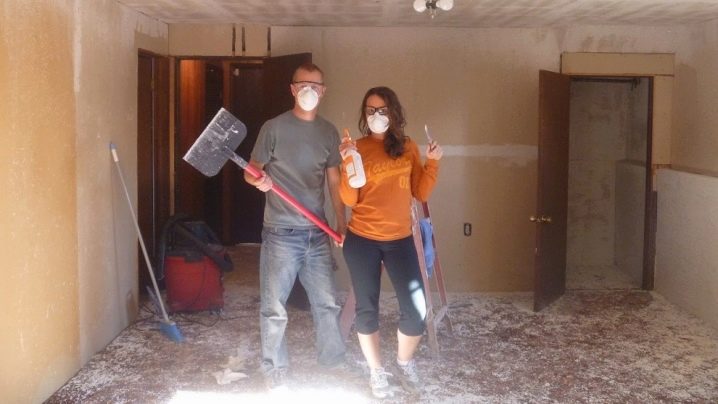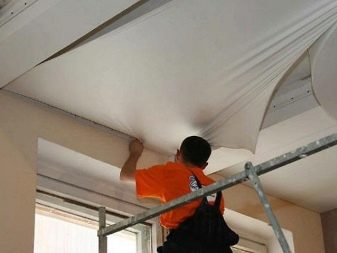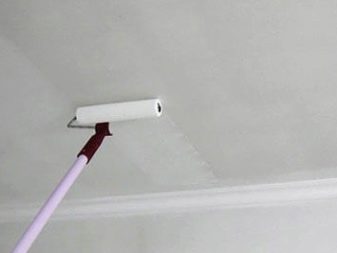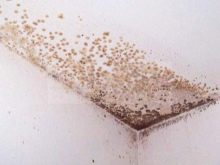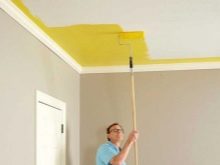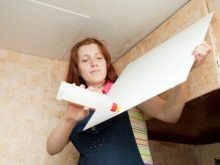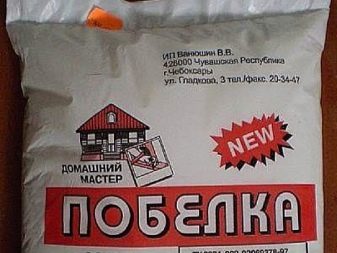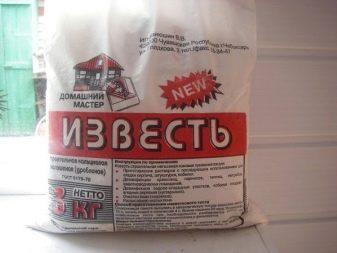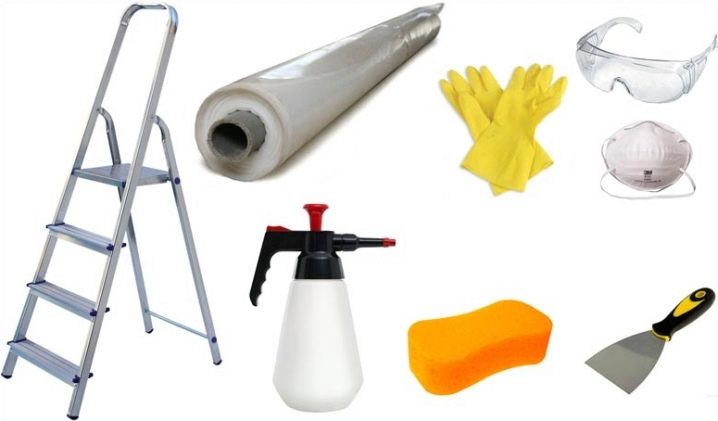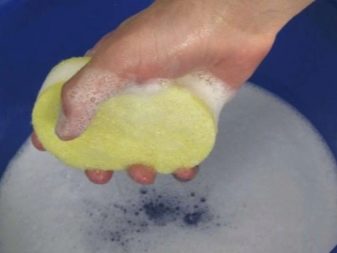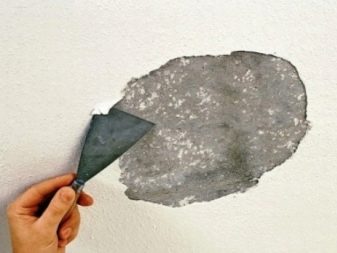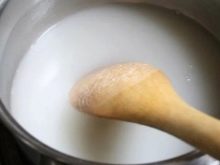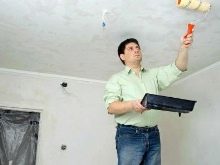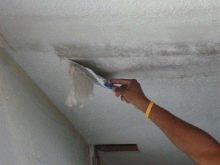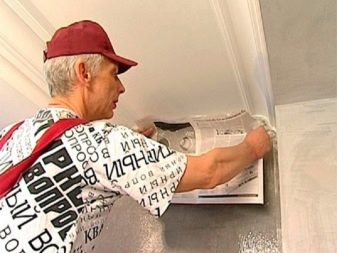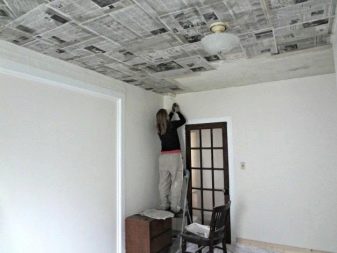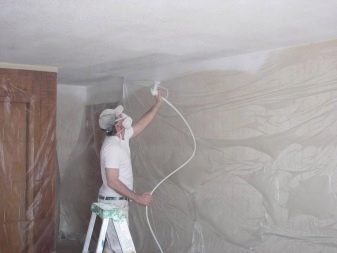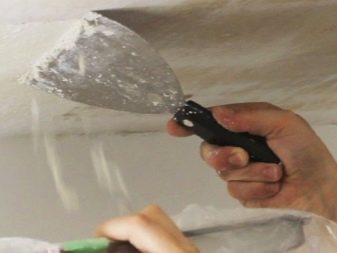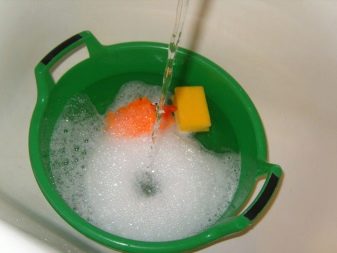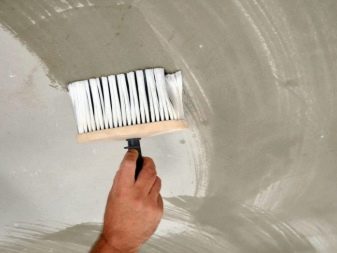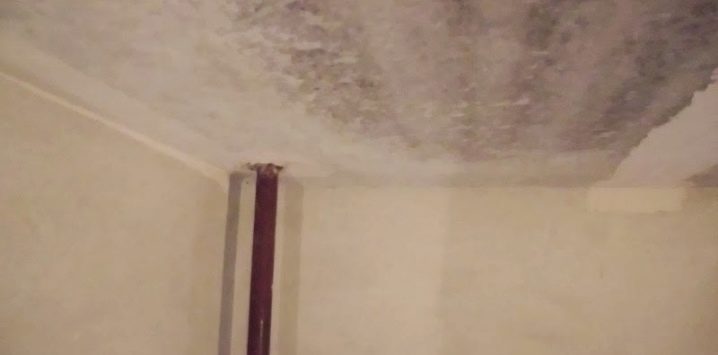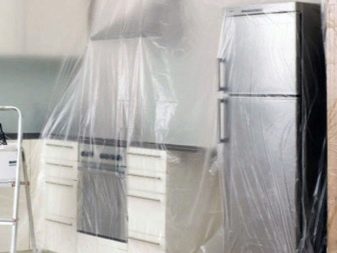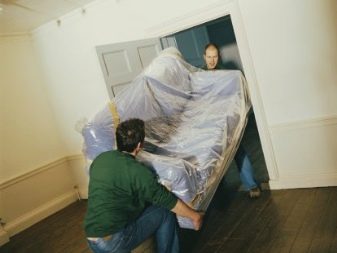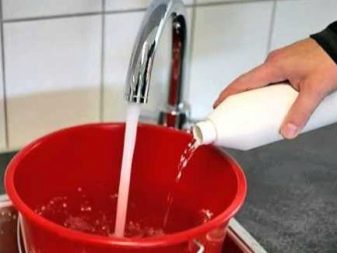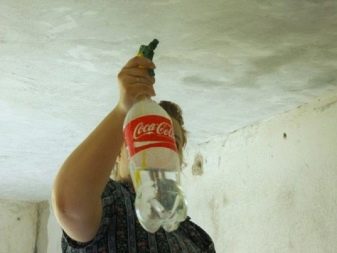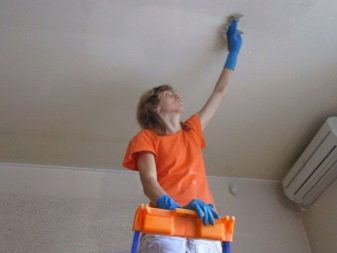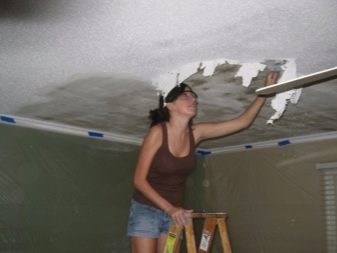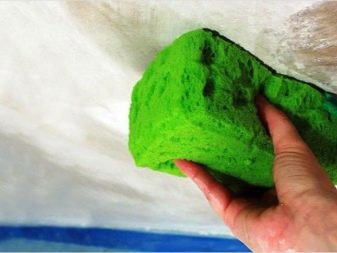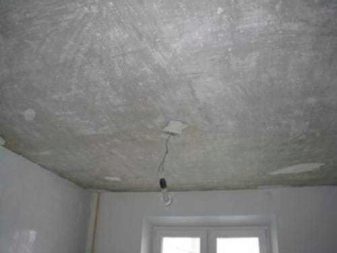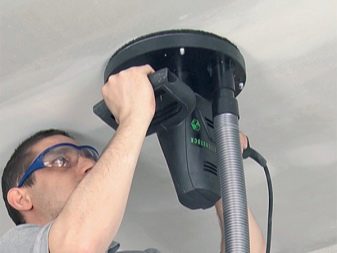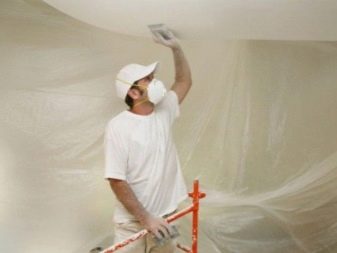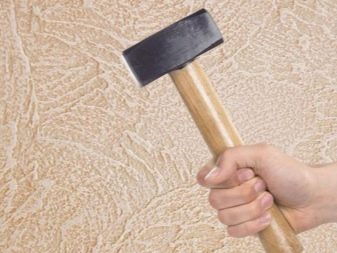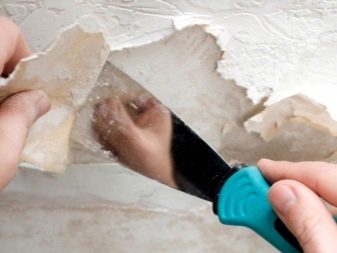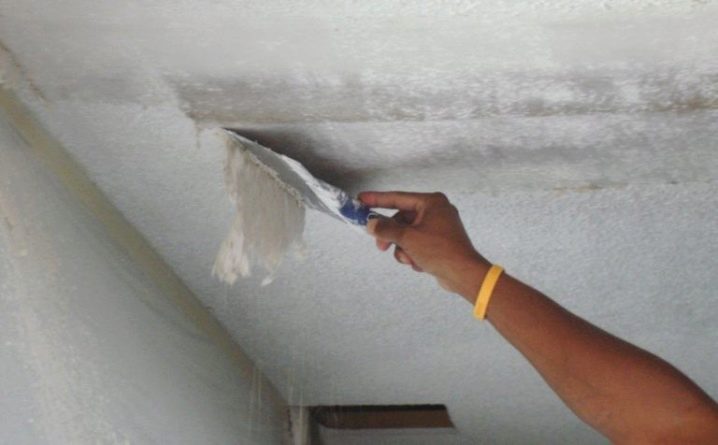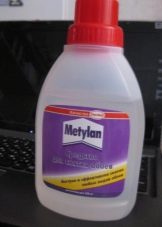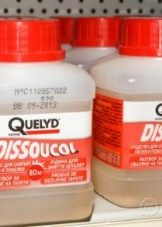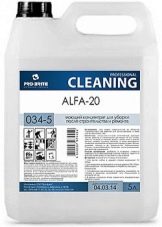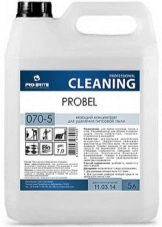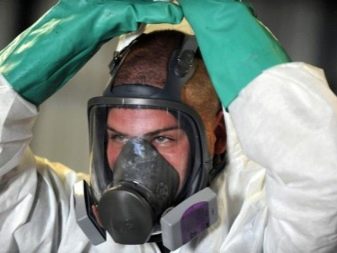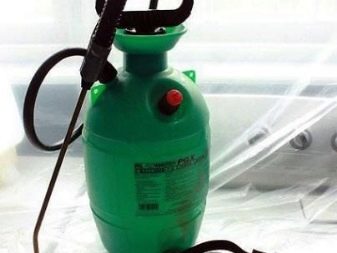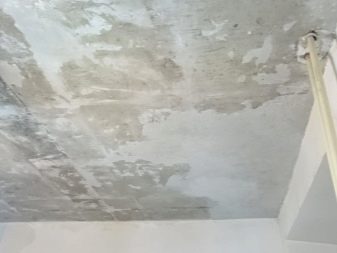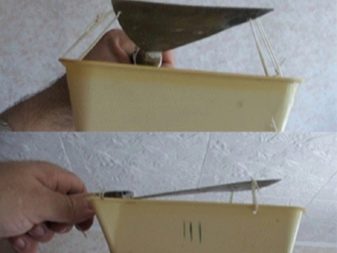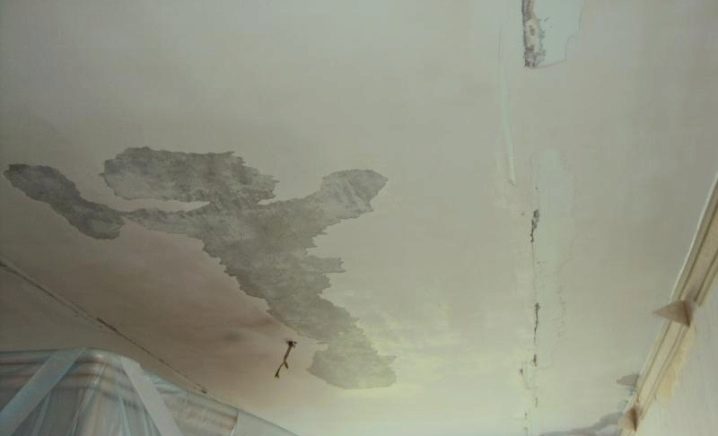How to wash whitewash from the ceiling?
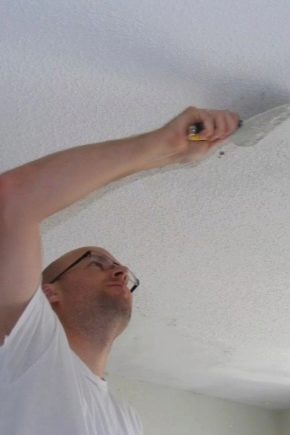
Repair of the ceiling usually begins with the removal of the old coating, but not all materials are easily dismantled. For example, to remove whitewash you need to spend a lot of time and effort. This is a dirty and long-term job, although not very difficult, if you know the details and follow the plan.
Special features
The surface treated with whitewashing absorbs glue and paint extremely poorly, which makes it impossible to carry out repairs without first removing the old coating. So, in any case, you will first have to wash the whitewash from the ceiling, and after that you begin to apply a new decorative layer. It is not worth the risk to think that in your case everything will happen wrong. Materials will be spoiled and time wasted.
Although in some cases you can really leave the ceiling whitewashed.
These options include the following situations:
- installation of a suspended ceiling or stretch;
- drawing a new layer of whitewash.
In the latter case, you will have to choose a similar material that already covers the surface. Use different whitewash options is prohibited. In any case, you will need to remove from the surface all existing pollution.
There are also options when removing the old decorative coating is required:
- the presence of mold and other microorganisms on the surface;
- application in the process of repair of water-based paints;
- use for facing polystyrene plates that need to be glued.
Types of whitewash
There are several types of whitewash. Before starting work on its elimination, it is necessary to determine the type of material with which you will have to work.
Each of the options can be removed in different ways.
- Chalk whitewash identify easily. All you need to do is swipe your finger across the ceiling. If the finger is painted white, then the basis of this material is chalk.This coating is relatively easy to remove.
- Lime - Another material from which whitewashing. It does not apply: if you hold your hand over it, it will remain clean. Get rid of the lime whitewash will be more difficult than from the chalk.
If the hand is not painted from the ceiling, then it can be painted, and not covered with lime whitewash. The paint is removed in other ways, the methods described below will not help. It will be required to be torn off by the dry method, also strong solutions which are used for paint are also produced.
Instruments
Further work on dismantling whitewash from the ceiling will require tools which it is desirable to prepare in advance:
- trowel and pan for it, you can replace the container with a scraper;
- spray;
- foam sponges that can be replaced with rollers or at least with rags;
- small hammer;
- water (preferably warm) and the capacity in which it will be contained;
- stepladder, you can use a high table or other suitable design;
- film and newspapers to protect furniture, floor and other elements of the interior;
- personal protective equipment, which includes gloves, special glasses, a hat and a respirator.
Withdrawals
Washing the whitewash from the ceiling still remains an urgent problem, which usually seriously slows down the process of repairing the room. Humanity seems to have thrown all its strength into solving this problem. But how then can you still explain the large amount of funds that cope with this task in two accounts?
- Soap solutionwhich can be used instead of ordinary warm water. This tool is more suitable for removing a small layer of decorative material. For its preparation it is necessary to take 2 tbsp. spoons of ordinary laundry soap, previously rubbed. This component can be replaced with a powder that is created on the basis of soap. Also, take 5 tablespoons of baking soda and dilute it all in 10 liters of hot water. The resulting cooled and filtered solution with a sponge rubbed the treated surface. We leave whitewash for swelling, after which it is easily removed with a spatula.
- Paste can be made on the basis of flour or starch. The prepared adhesive liquid is applied to the ceiling with a roller, which helps to cope with painting or a sponge.It is important not to miss the moment when the paste starts to set. It is necessary to quickly take up the spatula and remove the old coating.
- Glue Underlies the next trick, which is popular with builders. It is applied to old newspapers, which are then applied to the ceiling. It is important to keep one corner of the newspaper dry. We pull over this corner, and the newspaper departs along with the old decorative covering. This tool is better to use to remove a small layer of whitewash.
- Special construction toolwhich is sold in most hardware stores. It has a glue base, applied to the surface by spraying. You need to wait until the mixture is absorbed and dry. After this whitewashing is easily removed with a spatula.
On the shelves of construction stores are a large number of products from different brands. Some of them will be discussed below.
- Another solution that can be created at home is basically vinegar and any foam for the bathroom. At the base of the foam must be surfactants. You will need to take five liters of water, a tablespoon of regular table vinegar and a few caps of detergent.
To use any of these means is much better and more effective than just washing (flushing) the whitewash with plain water. Not to mention the dry method of stripping whitewash, the process of which is associated with a large amount of dust and debris.
How to shoot?
It is necessary to wash off the old whitewash from the surface in several stages. If you stick to the work plan, you can reduce the time spent, avoid common mistakes and get a decent result.
Room preparation
- The essence of this stage is to free the room from furniture, equipment and other items. It is advisable to endure everything. In the future, do not have to spend time on it to clean it all from dust, dirt and, in fact, the whitewash itself.
- If it is not possible to free up the room, then you can cover the objects with a film, to fix which you will need construction tape. In order to surely protect the interior from pollution, you need to put newspapers or large sheets of paper under the film.
- At the threshold of the room you need to put a wide wet rag. In the future, it will be easy to clean the dirt off the shoes when it is necessary to leave the repair area.Such a trick actually turns out to be very useful.
Workflow organization
If it is done correctly, it will help to quickly remove the old decorative layer, and will allow in the end to get a good result.
- In small containers, such as buckets, it is necessary to prepare warm and cold water.
- Water can be replaced by another means by which the removal of whitewash is carried out.
- Spray better to take a capacity of 0.5 liters. It will be more convenient in work.
- The water and sprayer should be in close proximity to you so that you can easily draw water as you use it.
The working process
This is the main stage of our repair.
- Standing on a stepladder or any other construction, we spray the selected product or water onto the surface. When applying the product, gaps should be avoided, but the ceiling should also be wetted abundantly.
- After 10 minutes, when the material is sufficiently saturated and swells, it is necessary to repeat the application of the agent / water.
- Now with a spatula, you can clear the ceiling from whitewashing with your own hands, without the assistance of outside help.
- Whitewashing should be removed in small wet areas.
Final stage
It consists in washing the ceiling and checking the quality of the work done.
- After completing work with a spatula, rinse the ceiling with warm water using a large sponge. The sponge needs to be squeezed out so that dirty water does not run off the walls, and there are no puddles on the floor.
- We use a dry and dry hand on the dried ceiling; it should not turn white, which will indicate good performance.
Let's open a small secret, which is useful if it was not possible to make your once bleached ceiling perfectly clean, and there are still traces on it. Before finishing your imperfectly cleaned ceiling, it is necessary to treat it with a special primer composition, which is suitable just for such cases.
There are also dry methods to remove whitewash, which we must mention. The essence of such techniques is the dismantling of the dry coating, which has not previously been treated with either water or special compounds. Remove it will be extremely difficult. Often, after the completion of repair work, the dust from the whitewash is found in the most secluded and unexpected places.
If this does not scare you, then it is better to replace the spatula with a grinding machine.There will be a lot of dust, so you need to carefully cover the floor, windows and doors with building or plastic wrap. The room is necessarily released from all items. Initially, a coarse-grained paper is fixed on the typewriter, which will allow to remove large elements of whitewash. After that, fine-grained paper is used.
Another method is based on using a washing vacuum cleaner, we recommend cutting it off immediately. The main reason for this categorical is the high probability of failure of expensive equipment. In this case, the risk is unjustified.
The following method is suitable for a thick coating layer, in other cases it is practically not used. To implement it, you need to have on hand a small hammer and trowel. The surface is tapped with a hammer. The strength should be small, it is necessary to pay attention to each site.
After such manipulations, whitewashing will easily move away from the base, it will only remain to be pushed with a spatula. It is better to enlist the support of an assistant who will stand at the bottom with capacity. Whitewashing will immediately fall into the bucket / basin, while forming a minimum of dust and dirt.
Whitewashing can keep on the plaster, which is found after the completion of the work. It is not necessary to clean all plastered places. It is necessary to identify areas that are unstable on the surface, they will have to be cleaned.
To determine the strength of the coating will need to tap it. From sites that are in doubt, have to get rid of. For this fit the already familiar spatula. If the plaster keeps well and is difficult to remove, it can be left.
Manufacturers
We have already mentioned special trains, but I would like to study the manufacturers in more detail.
After all, in the hardware store you can get confused from the abundance of brands.
- Quelyd Dissoucol or Metylan - two tools that are intended for easy removal of whitewash and removal of old wallpaper. They are characterized by good penetrating power, therefore they can be used even for thick layers. Available in the form of concentrated solutions that are diluted in water.
- Probel Tools designed to work with chalk and gypsum whitewash, well remove dust from surfaces. They are odorless and color professional concentrates with a neutral pH.Valued for lack of divorce.
- Alfa-20 tool designed to remove all types of whitewash. Also, this composition is excellent at removing various kinds of plaque and cement dust. The concentrate has an apple smell, is colored green.
The basis of this tool is an acid, so it is potent and requires the use of personal protective equipment. But in terms of efficiency, it has no equal. In the process of work, no stains are formed, and various types of contaminants are removed from the surface (rust, leaks, stains of unknown origin).
These funds, although costing more than traditional methods of preparing solutions, but they are quite concentrated, so one bottle is enough to handle a large area. It is easy to work with such solutions, and the result is more effective in comparison with the products prepared at home. The choice is always yours.
Tips and tricks
- If a white mash flows through the spatula during the cleaning process, it means that you managed not only to wet, but to wash out the whitewash. Now you need to wait a bit, because the water got too much, and it should be absorbed.
- If, when trying to remove whitewash, a lot of dust is formed, you will need to moisten the surface a little more.
- Do not be lazy to make furniture from the room in which the repair work will be carried out. Believe me, it will be much more difficult to remove whitening traces and it will take a lot of time to do it.
- Under the spatula it is better to substitute a special container into which the removed material will immediately fall; such a trick will allow you to rid the room of dirt and clean the room without any extra effort.
- It is better to divide the working area into several working areas: while one will be soaked, on the other you can remove the already swollen whitewash.
Check the thickness of the decorative layer should be carried out before the work on its dismantling. This will allow more efficient selection of tools for its removal.
- The selected tool or method is best tested on a small surface area.
- The application of water or special means is best done in several stages.
- When choosing a means of pricing it can talk about the degree of concentration and efficiency.
- You should not remove whitewash to concrete, but you still have to remove weak plaster.
Let the dismantling of whitewash does not seem to you a difficult job, the performance of which is only possible for professionals. In the estimate, this work is very expensive, although it can be done independently, without any experience.
How to remove the whitewash from the ceiling, see the following video.
